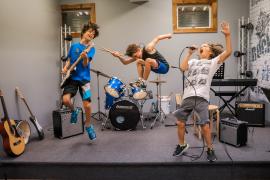Let’s face it; our collective national education system has some issues. Some might even say it needs a complete overhaul. Teachers are often overextended and under-funded, and the resources available within the classroom for hands-on learning can sometimes be sketchy at best. Yes, despite the very best of intentions, students run the risk of getting lost in the shuffle, lumped in with the masses, and even written off if standardized tests aren’t their forte. When faced with that day in and day out, the educational future for the squirming-in-his-seat child, the quiet one at the back of the room, or the bored-to-tears daydreamer could be bleak indeed. But what if there was a solution to the doldrums of boxed-in learning? What if we followed that bored student’s gaze out the window and into the woods? What if we gave her and the rest of her class interactive, experiential learning in an atmosphere guaranteed to leave an impression? And what if we allowed them to have fun in the process?
Such is the glory and the opportunity of the school-camp partnership.
Camps aren’t just for summertime. More and more they are becoming an integral part of school curriculums across the country in environmental sciences, history, leadership, and more.
Jeff Cheley, president of Cheley Colorado Camps, says one of the greatest benefits of schools incorporating camp experiences into their curriculum is, “We see a lot of times children who don’t do as well in the classroom do great when they are outdoors and moving around and active. It’s almost like a lab where you’re doing more than talking about it.”
Jane Sanborn, executive director of Sanborn Western Camps, agrees. “The greatest benefits are that these programs get kids outdoors and into an active learning environment,” she said. “Many kids thrive in this environment. We hear over and over again that an individual child ‘felt smarter.’ They also gain the social and emotional benefits of living with their peers for a few days.”
Additionally, Sanborn explained, “We use a curriculum based on role-playing so that students, for instance, learn about earth science by taking the role of prospectors. They learn forest ecology by taking the role of woodsman, and local history by taking the role of homesteaders. We have a dozen different Discovery Groups and each meets part of the state educational standards.”
Lesley Billiard has been the district-level coordinator for Colorado District 20’s High Trails program through Sanborn Western Camps for twelve years, and the school system has been partnering with the camp for longer than that. “We’re working on 37,000 sixth graders having attended High Trails in thirty-five years,” she said. “We have a great relationship with the Sanborn Camps.”
With a working cattle ranch and an old homestead on the property, Billiard said District 20 students get a good dose of both history and environmental sciences during their stay. And she praises the camp for working closely with the school system to stay current with changing curriculum standards. “They make the experience everything it can possibly be for the kids,” she said.
Bradford Woods in Southern Indiana is another camp that offers programs during the school year to work in tandem with schools’ curriculum and enhance students’ experiential learning opportunities — primarily about the environment. According to Bradford Woods’ information, programs “are designed to be an extension of the classroom combining academic, social, and recreational experiences in a fun atmosphere. Whether writing a poem about a soaring Bald Eagle, collecting aquatic insects for a biotic index, or listening to Native American legends while gazing into a starry night sky, students see their learning come alive.”
Melissa Garrity, a fifth grade teacher at Douglas MacArthur Elementary School in Indiana’s Perry Township School Corporation, whose students attend Bradford Woods for a unit on the environment, said, “We are constantly reverting back to our trip to Bradford Woods. We use the learned information across the curriculum all year long.”
Garrity said her class focuses on the watershed and conservation of natural resources. “We also include canoeing and rock climbing to give our students a chance to do some fun activities that they may otherwise never have the opportunity to try,” she added.
Perhaps more important than the actual facts they learn, said Garrity, “The bonding that the students have with one another is the biggest perk of this program. Secondly would be the bonding our staff is able to have with each other and with our students. The benefits are limitless for teachers once we return to the classroom. Students have a great respect and appreciation for us and one another.”
Cheley agrees that the education students from schools such as St. Clements Episcopal School in El Paso, Texas, and the Good Shepherd School in Houston receive while at camp for eight or nine days goes way beyond gaining a better understanding and passion for the natural world. “Long term it’s very important,” he said. “They’re away from school but they’re learning life skills — how to live in a community, how to depend on each other — there’s teamwork, compromises, and many other things.”
So while the debate rages on about what needs to be done to overcome the current challenges of our nation’s education system, it seems clear that camp is one very simple way to increase students’ learning potential and their joy in doing so by leaps and bounds.
Published in November 2010 by the American Camp Association.


